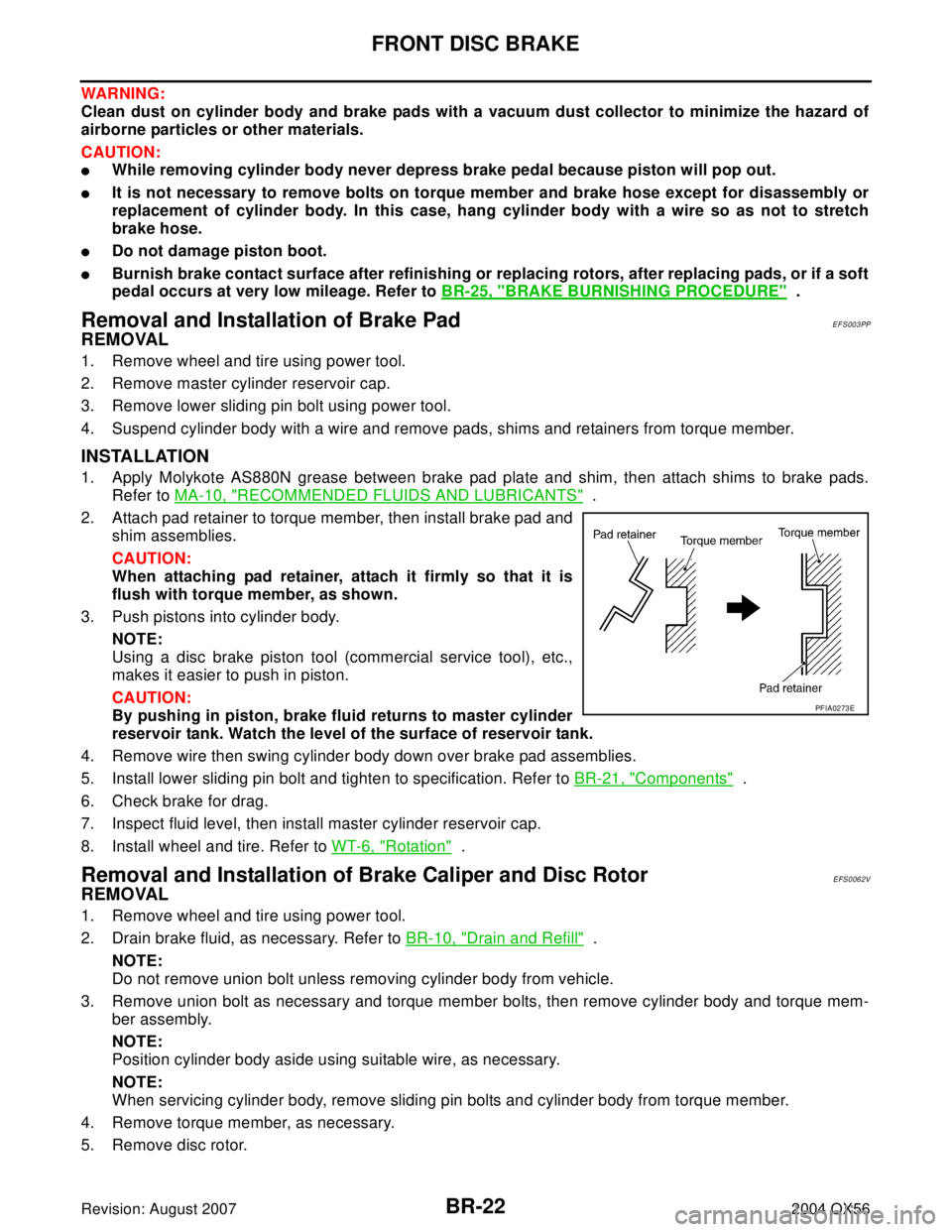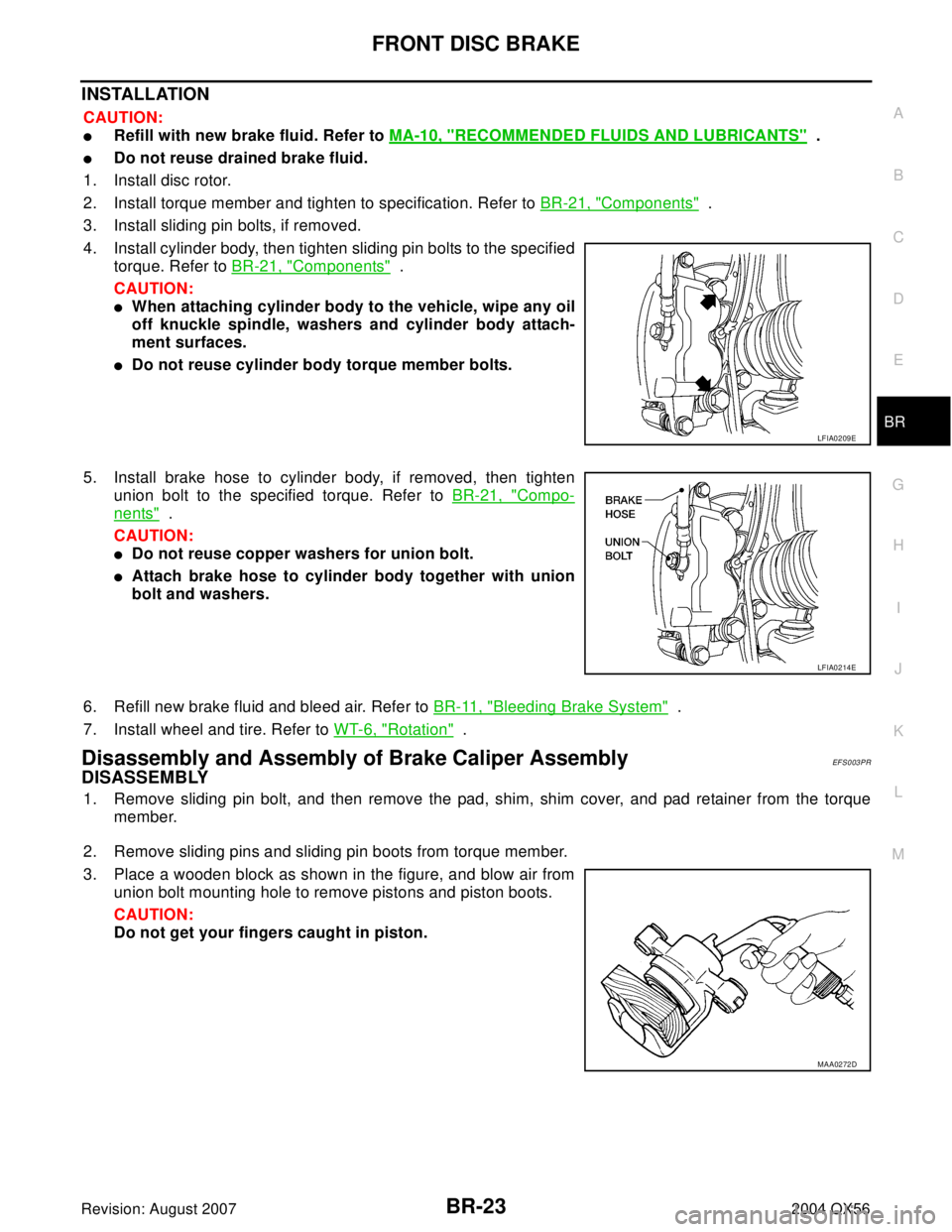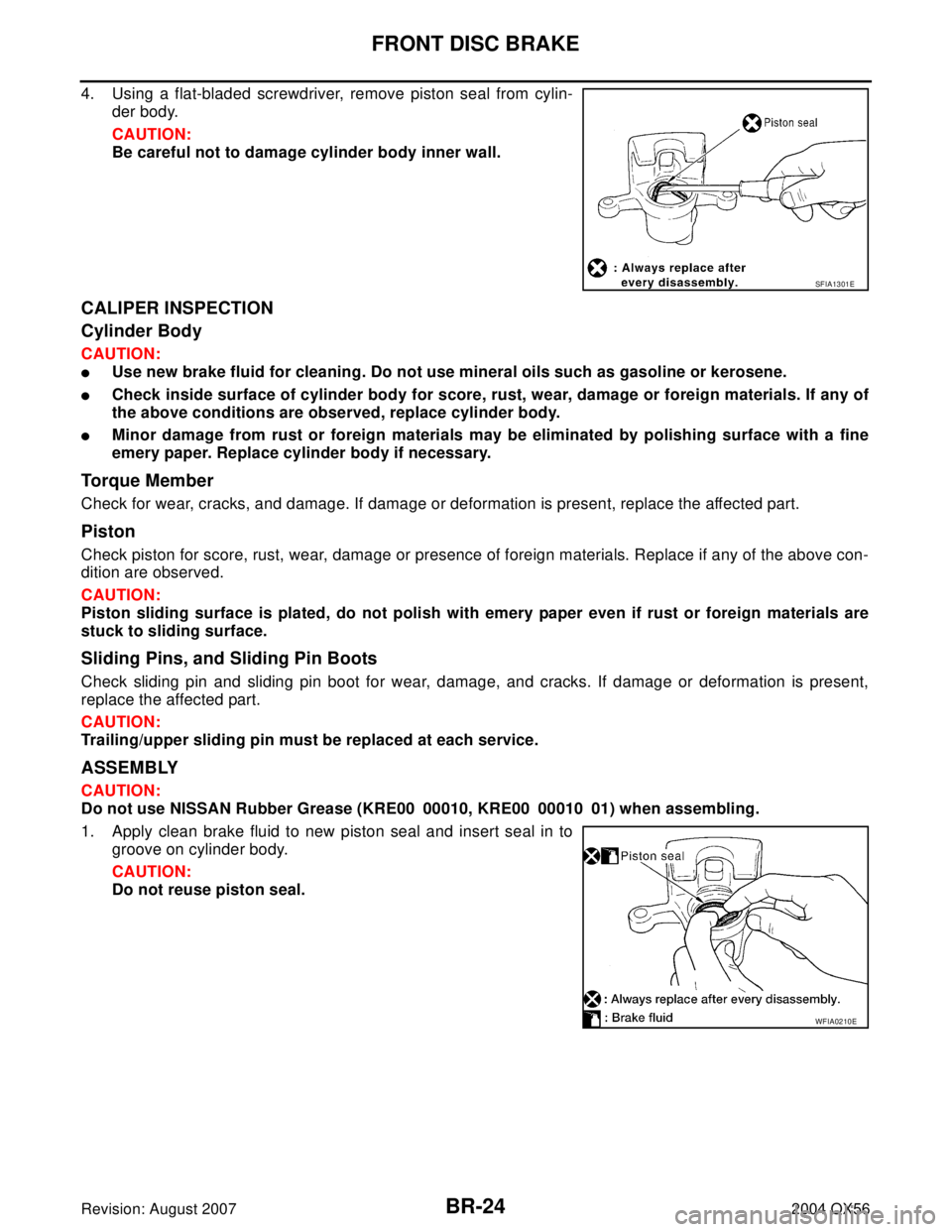Page 982 of 3371

PRECAUTIONS
BR-3
C
D
E
G
H
I
J
K
L
MA
B
BR
Revision: August 20072004 QX56
PRECAUTIONSPFP:00001
Precautions for Supplemental Restraint System (SRS) “AIR BAG” and “SEAT
BELT PRE-TENSIONER”
EFS003P3
The Supplemental Restraint System such as “AIR BAG” and “SEAT BELT PRE-TENSIONER”, used along
with a front seat belt, helps to reduce the risk or severity of injury to the driver and front passenger for certain
types of collision. This system includes seat belt switch inputs and dual stage front air bag modules. The SRS
system uses the seat belt switches to determine the front air bag deployment, and may only deploy one front
air bag, depending on the severity of a collision and whether the front occupants are belted or unbelted.
Information necessary to service the system safely is included in the SRS and SB section of this Service Man-
ual.
WA RN ING:
�To avoid rendering the SRS inoperative, which could increase the risk of personal injury or death
in the event of a collision which would result in air bag inflation, all maintenance must be per-
formed by an authorized NISSAN/INFINITI dealer.
�Improper maintenance, including incorrect removal and installation of the SRS, can lead to per-
sonal injury caused by unintentional activation of the system. For removal of Spiral Cable and Air
Bag Module, see the SRS section.
�Do not use electrical test equipment on any circuit related to the SRS unless instructed to in this
Service Manual. SRS wiring harnesses can be identified by yellow and/or orange harnesses or
harness connectors.
Precautions for Brake SystemEFS0062U
�Refer to MA-10, "RECOMMENDED FLUIDS AND LUBRICANTS" for recommended brake fluid.
�Do not reuse drained brake fluid.
�Be careful not to splash brake fluid on painted areas.
�To clean or wash all parts of master cylinder, disc brake caliper and wheel cylinder, use clean brake fluid.
�Do not use mineral oils such as gasoline or kerosene. They will ruin rubber parts of the hydraulic system.
�Use flare nut wrench when removing and installing brake tube.
�Always check tightening torque when installing brake lines.
�Before working, turn ignition switch to OFF and disconnect con-
nectors for ABS actuator and electric unit (control unit) or battery
terminals.
�Burnish the brake contact surfaces after refinishing or replacing
drums or rotors, after replacing pads or linings, or if a soft pedal
occurs at very low mileage. Refer to BR-25, "
BRAKE BURNISH-
ING PROCEDURE" .
WA RN ING:
�Clean brake pads and shoes with a waste cloth, then wipe
with a dust collector.SBR6 86 C
Page 983 of 3371
BR-4
PREPARATION
Revision: August 20072004 QX56
PREPARATIONPFP:00002
Special Service ToolEFS0062T
The actual shapes of Kent-Moore tools may differ from those of special service tools illustrated here.
Commercial Service ToolsEFS003P5
Tool number
(Kent-Moore No.)
Tool nameDescription
—
(J-46532)
Brake and clutch pedal height measure-
ment toolMeasuring brake pedal height.
LFIA0227E
Tool nameDescription
1. Flare nut crowfoot
2. Torque wrenchRemoving and installing brake piping.
a: 10 mm (0.39 in) / 12 mm (0.47 in)
Power toolRemoving bolts, nuts, and screws.
S-NT360
PBIC0190E
PBIC0191E
Page 990 of 3371
BRAKE FLUID
BR-11
C
D
E
G
H
I
J
K
L
MA
B
BR
Revision: August 20072004 QX56
Bleeding Brake SystemEFS003PB
CAUTION:
While bleeding, pay attention to master cylinder fluid level.
1. Turn ignition switch OFF and disconnect ABS actuator and electric unit (control unit) connector or battery
negative cable.
2. Connect a vinyl tube to the rear right bleed valve.
3. Fully depress brake pedal 4 to 5 times.
4. With brake pedal depressed, loosen bleed valve to let the air out, and then tighten it immediately.
5. Repeat steps 3 and 4 until no more air comes out.
6. Tighten bleed valve to the specified torque. Refer to BR-21, "
Components" (front disc brake), BR-27,
"Components" (rear disc brake).
7. Repeat steps 2 through 6, with master cylinder reservoir tank filled at least half way, bleed air from the
front left, rear left, and front right bleed valve.
Page 998 of 3371

BRAKE BOOSTER
BR-19
C
D
E
G
H
I
J
K
L
MA
B
BR
Revision: August 20072004 QX56
INSTALLATION
1. Loosen lock nut to adjust input rod length so that the length B (in
the figure) satisfies the specified value.
2. After adjusting “B”, temporarily tighten lock nut and install
booster assembly to the vehicle.
�Install a gaskets and spacer block between booster assembly
and the dash panel.
3. Connect brake pedal with clevis of input rod.
4. Install pedal bracket mounting nuts and tighten them to the
specified torque.
5. Install brake piping from brake master cylinder to ABS actuator. Refer to BR-12, "
Hydraulic Circuit" .
6. Connect active boost and delta stroke sensor harness connectors to brake booster assembly.
7. Connect vacuum hose to brake booster.
8. Install master cylinder to booster assembly. Refer to BR-18, "
Removal and Installation" .
9. Adjust the height and play of brake pedal.
10. Tighten lock nut of input rod to the specified torque.
11. Install engine air duct assembly. Refer to EM-14, "
Removal and Installation" .
12. Install engine room cover with power tool. Refer to EM-11, "
Removal and Installation" .
13. Refill with new brake fluid and bleed air. Refer to BR-11, "
Bleeding Brake System" . Length “B” : 125 mm (4.92 in)
SGIA0060E
Page 1000 of 3371
FRONT DISC BRAKE
BR-21
C
D
E
G
H
I
J
K
L
MA
B
BR
Revision: August 20072004 QX56
FRONT DISC BRAKEPFP:41000
On-vehicle InspectionEFS003PN
PAD WEAR INSPECTION
�Inspect the thickness of pad through cylinder body inspection
hole. Use a scale for inspection if necessary.
ComponentsEFS003PO
Standard thickness : 11.88 mm (0.468 in)
Repair limit thickness : 1.0 mm (0.039 in)
BRA0010D
1. Upper sliding pin 2. Sliding pin boot 3. Torque member bolt
4. Torque member 5. Piston seal 6. Piston
7. Inner pad 8. Pad retainer 9. Outer pad
10. Piston boot 11. Union bolt 12. Copper washer
13. Sliding pin bolt 14. Bleed valve 15. Cylinder body
16. Cap 17. Brake hose 18. Lower sliding pin
WFIA0393E
Page 1001 of 3371

BR-22
FRONT DISC BRAKE
Revision: August 20072004 QX56
WAR NIN G:
Clean dust on cylinder body and brake pads with a vacuum dust collector to minimize the hazard of
airborne particles or other materials.
CAUTION:
�While removing cylinder body never depress brake pedal because piston will pop out.
�It is not necessary to remove bolts on torque member and brake hose except for disassembly or
replacement of cylinder body. In this case, hang cylinder body with a wire so as not to stretch
brake hose.
�Do not damage piston boot.
�Burnish brake contact surface after refinishing or replacing rotors, after replacing pads, or if a soft
pedal occurs at very low mileage. Refer to BR-25, "
BRAKE BURNISHING PROCEDURE" .
Removal and Installation of Brake PadEFS003PP
REMOVAL
1. Remove wheel and tire using power tool.
2. Remove master cylinder reservoir cap.
3. Remove lower sliding pin bolt using power tool.
4. Suspend cylinder body with a wire and remove pads, shims and retainers from torque member.
INSTALLATION
1. Apply Molykote AS880N grease between brake pad plate and shim, then attach shims to brake pads.
Refer to MA-10, "
RECOMMENDED FLUIDS AND LUBRICANTS" .
2. Attach pad retainer to torque member, then install brake pad and
shim assemblies.
CAUTION:
When attaching pad retainer, attach it firmly so that it is
flush with torque member, as shown.
3. Push pistons into cylinder body.
NOTE:
Using a disc brake piston tool (commercial service tool), etc.,
makes it easier to push in piston.
CAUTION:
By pushing in piston, brake fluid returns to master cylinder
reservoir tank. Watch the level of the surface of reservoir tank.
4. Remove wire then swing cylinder body down over brake pad assemblies.
5. Install lower sliding pin bolt and tighten to specification. Refer to BR-21, "
Components" .
6. Check brake for drag.
7. Inspect fluid level, then install master cylinder reservoir cap.
8. Install wheel and tire. Refer to WT-6, "
Rotation" .
Removal and Installation of Brake Caliper and Disc RotorEFS0062V
REMOVAL
1. Remove wheel and tire using power tool.
2. Drain brake fluid, as necessary. Refer to BR-10, "
Drain and Refill" .
NOTE:
Do not remove union bolt unless removing cylinder body from vehicle.
3. Remove union bolt as necessary and torque member bolts, then remove cylinder body and torque mem-
ber assembly.
NOTE:
Position cylinder body aside using suitable wire, as necessary.
NOTE:
When servicing cylinder body, remove sliding pin bolts and cylinder body from torque member.
4. Remove torque member, as necessary.
5. Remove disc rotor.
PFIA0273E
Page 1002 of 3371

FRONT DISC BRAKE
BR-23
C
D
E
G
H
I
J
K
L
MA
B
BR
Revision: August 20072004 QX56
INSTALLATION
CAUTION:
�Refill with new brake fluid. Refer to MA-10, "RECOMMENDED FLUIDS AND LUBRICANTS" .
�Do not reuse drained brake fluid.
1. Install disc rotor.
2. Install torque member and tighten to specification. Refer to BR-21, "
Components" .
3. Install sliding pin bolts, if removed.
4. Install cylinder body, then tighten sliding pin bolts to the specified
torque. Refer to BR-21, "
Components" .
CAUTION:
�When attaching cylinder body to the vehicle, wipe any oil
off knuckle spindle, washers and cylinder body attach-
ment surfaces.
�Do not reuse cylinder body torque member bolts.
5. Install brake hose to cylinder body, if removed, then tighten
union bolt to the specified torque. Refer to BR-21, "
Compo-
nents" .
CAUTION:
�Do not reuse copper washers for union bolt.
�Attach brake hose to cylinder body together with union
bolt and washers.
6. Refill new brake fluid and bleed air. Refer to BR-11, "
Bleeding Brake System" .
7. Install wheel and tire. Refer to WT-6, "
Rotation" .
Disassembly and Assembly of Brake Caliper AssemblyEFS003PR
DISASSEMBLY
1. Remove sliding pin bolt, and then remove the pad, shim, shim cover, and pad retainer from the torque
member.
2. Remove sliding pins and sliding pin boots from torque member.
3. Place a wooden block as shown in the figure, and blow air from
union bolt mounting hole to remove pistons and piston boots.
CAUTION:
Do not get your fingers caught in piston.
LFIA0209E
LFIA0214E
MAA0272D
Page 1003 of 3371

BR-24
FRONT DISC BRAKE
Revision: August 20072004 QX56
4. Using a flat-bladed screwdriver, remove piston seal from cylin-
der body.
CAUTION:
Be careful not to damage cylinder body inner wall.
CALIPER INSPECTION
Cylinder Body
CAUTION:
�Use new brake fluid for cleaning. Do not use mineral oils such as gasoline or kerosene.
�Check inside surface of cylinder body for score, rust, wear, damage or foreign materials. If any of
the above conditions are observed, replace cylinder body.
�Minor damage from rust or foreign materials may be eliminated by polishing surface with a fine
emery paper. Replace cylinder body if necessary.
Torque Member
Check for wear, cracks, and damage. If damage or deformation is present, replace the affected part.
Piston
Check piston for score, rust, wear, damage or presence of foreign materials. Replace if any of the above con-
dition are observed.
CAUTION:
Piston sliding surface is plated, do not polish with emery paper even if rust or foreign materials are
stuck to sliding surface.
Sliding Pins, and Sliding Pin Boots
Check sliding pin and sliding pin boot for wear, damage, and cracks. If damage or deformation is present,
replace the affected part.
CAUTION:
Trailing/upper sliding pin must be replaced at each service.
ASSEMBLY
CAUTION:
Do not use NISSAN Rubber Grease (KRE00 00010, KRE00 00010 01) when assembling.
1. Apply clean brake fluid to new piston seal and insert seal in to
groove on cylinder body.
CAUTION:
Do not reuse piston seal.
SFIA1301E
WFIA0210E